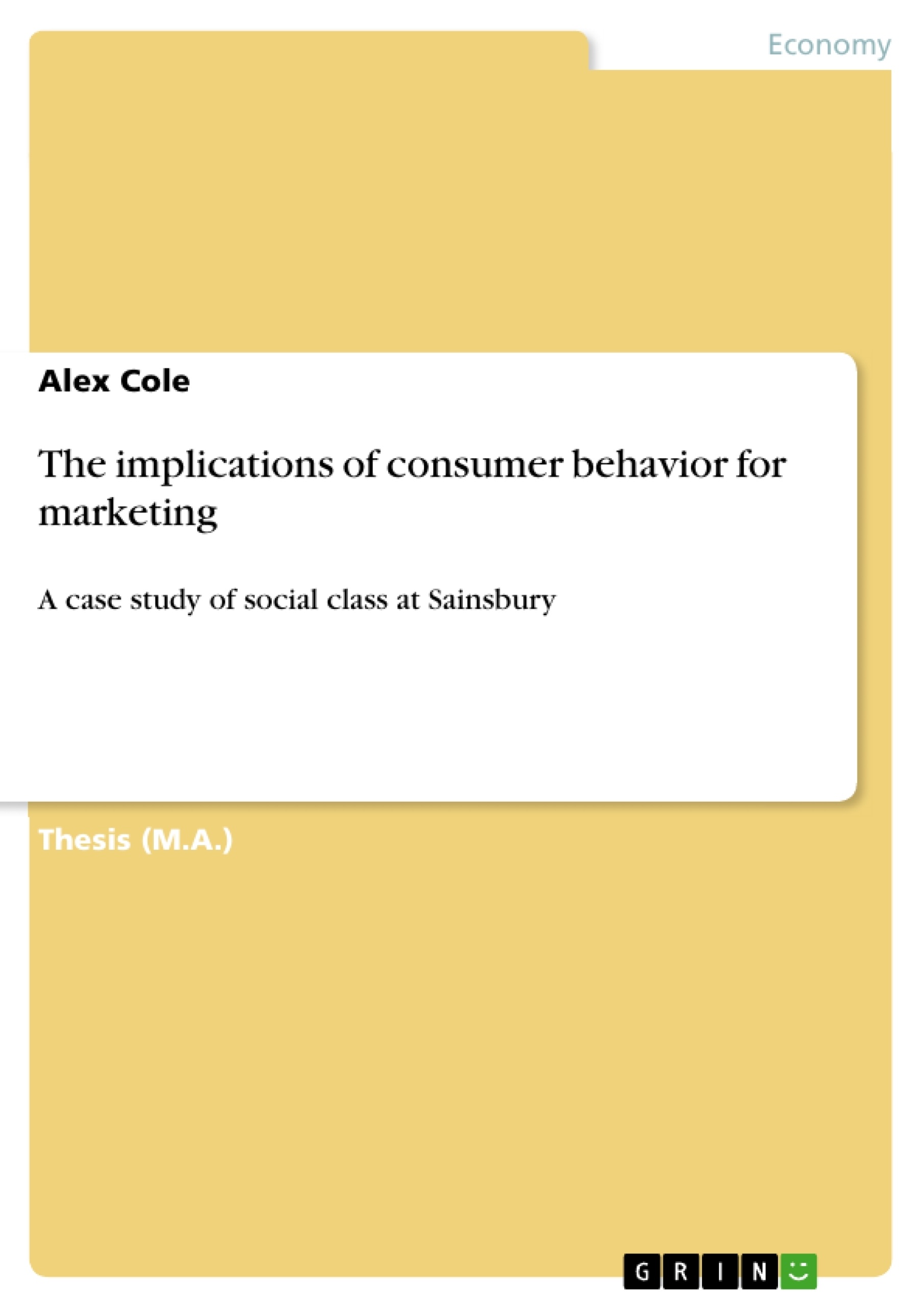
The implications of consumer behavior for marketing
Magisterarbeit, 2012
60 Seiten, Note: A
Leseprobe
Table of Contents
- Chapter One: Introduction
- Background
- Defining Consumer Behavior
- Consumer Behavior in Context of Social Class
- Aims and Objectives of Research
- Research Questions
- Significance and Scope of Research
- Research Structure
- Chapter Two: Literature Review
- Chapter Three: Methodology
- Chapter Four: Data Findings and Presentation
- Chapter Five: Data Interpretation and Analysis
Objectives and Key Themes
This research aims to investigate the marketing implications of social class influence on consumer behavior at Sainsbury's. It explores how different social classes exhibit varying behaviors, attitudes, and preferences regarding purchasing decisions and consumption patterns. The study utilizes a triangulation methodology and a convenience sample to gather data through questionnaires.
- The relationship between social class and consumer behavior at Sainsbury's.
- The impact of social class on spending habits and product preferences.
- The influence of social class on information seeking behavior and shopping channels.
- The role of social class in shaping attitudes towards financial products and investments.
- Marketing implications of understanding social class differences in consumer behavior.
Chapter Summaries
Chapter One: Introduction: This chapter sets the stage for the research by introducing the significance of consumer behavior in today's competitive market. It defines consumer behavior, highlighting its importance in understanding consumer decision-making processes. The chapter emphasizes the role of social class as a crucial factor influencing consumer behavior and clearly states the research aims, questions, significance, and structure of the study. It provides a foundation for the subsequent literature review and methodology chapters by highlighting the research's central focus on the intersection of consumer behavior and social class within the Sainsbury's context.
Chapter Two: Literature Review: This chapter delves into existing literature on consumer behavior and social class. It provides definitions of key terms, explores different social class measurement methods, and examines the established link between social class and various aspects of consumer behavior, such as social image, leisure activities, living styles, motivation, and shopping behaviors. The review likely synthesizes findings from various studies to establish a comprehensive theoretical framework for the research and to contextualize the study's findings within the broader academic landscape concerning consumer behavior and social stratification. The chapter concludes with a summary of the reviewed literature, establishing a basis for the research methodology and the subsequent analysis of data.
Chapter Three: Methodology: This chapter details the research design and methods employed in the study. It outlines the research philosophy, approach (likely quantitative or mixed methods given the questionnaire), and methods used to collect and analyze data. The chapter discusses the sampling strategy (convenience sampling of 75 Sainsbury's consumers), data collection techniques (questionnaires), and data types (likely primary). It also addresses issues of validity, reliability, and research ethics. The methodology section is crucial in ensuring the study's rigor and transparency, providing a framework for evaluating the credibility and generalizability of the findings.
Chapter Four: Data Findings and Presentation: This chapter presents the results of the data collected. It likely includes descriptive statistics summarizing the respondents' demographics, spending habits, shopping preferences, and media consumption. This chapter is a descriptive account of the primary data collected from the survey, presenting the raw findings in a clear and organized manner suitable for interpretation in the following chapter. Visualizations such as tables and charts likely accompanied the numerical data to highlight trends and patterns relevant to social class and consumer behaviors within the Sainsbury's customer base.
Chapter Five: Data Interpretation and Analysis: This chapter interprets the findings presented in Chapter Four, focusing on the relationship between social class and various aspects of consumer behavior at Sainsbury's. It analyzes the data to identify significant differences in spending patterns, shopping habits, product preferences, and media usage across different social classes. This chapter links the observed patterns to the literature reviewed in Chapter Two, validating and contextualizing the findings. It forms the core of the research by addressing the key research questions and providing evidence-based insights into the marketing implications of understanding social class differences in consumer behavior at Sainsbury's.
Keywords
Consumer behavior, social class, Sainsbury's, marketing implications, spending habits, product preferences, shopping behavior, information seeking, online shopping, financial products, market segmentation, triangulation methodology, quantitative research.
Frequently Asked Questions: A Comprehensive Language Preview on Consumer Behavior at Sainsbury's
What is the main topic of this research?
This research investigates the marketing implications of social class influence on consumer behavior at Sainsbury's. It explores how different social classes exhibit varying behaviors, attitudes, and preferences regarding purchasing decisions and consumption patterns.
What are the key objectives of the research?
The research aims to understand the relationship between social class and consumer behavior at Sainsbury's, including the impact on spending habits, product preferences, information seeking behavior, attitudes towards financial products, and the overall marketing implications of these differences.
What methodology was used in this research?
The study utilizes a triangulation methodology and a convenience sample (75 Sainsbury's consumers) to gather data primarily through questionnaires. The methodology section details the research design, data collection techniques, and addresses validity, reliability, and ethics.
How is the research structured?
The research is structured into five chapters: Chapter One (Introduction), Chapter Two (Literature Review), Chapter Three (Methodology), Chapter Four (Data Findings and Presentation), and Chapter Five (Data Interpretation and Analysis).
What are the key themes explored in the research?
Key themes include the relationship between social class and consumer behavior at Sainsbury's; the impact of social class on spending habits and product preferences; the influence of social class on information seeking behavior and shopping channels; and the role of social class in shaping attitudes towards financial products and investments.
What does Chapter One cover?
Chapter One introduces the significance of consumer behavior, defines it within the context of social class, and outlines the research aims, questions, significance, and structure.
What does Chapter Two cover?
Chapter Two reviews existing literature on consumer behavior and social class, exploring different social class measurement methods and the established link between social class and various aspects of consumer behavior.
What does Chapter Three cover?
Chapter Three details the research design and methods, including the sampling strategy (convenience sampling), data collection techniques (questionnaires), and data analysis approaches. It also addresses validity, reliability, and research ethics.
What does Chapter Four cover?
Chapter Four presents the descriptive statistics summarizing respondents' demographics, spending habits, shopping preferences, and media consumption. It presents the raw findings in a clear and organized manner using tables and charts.
What does Chapter Five cover?
Chapter Five interprets the findings from Chapter Four, analyzing the relationship between social class and various aspects of consumer behavior at Sainsbury's. It links the observed patterns to the literature review and addresses the key research questions.
What are the keywords associated with this research?
Keywords include: Consumer behavior, social class, Sainsbury's, marketing implications, spending habits, product preferences, shopping behavior, information seeking, online shopping, financial products, market segmentation, triangulation methodology, quantitative research.
Details
- Titel
- The implications of consumer behavior for marketing
- Untertitel
- A case study of social class at Sainsbury
- Hochschule
- University of Canberra
- Veranstaltung
- MA
- Note
- A
- Autor
- Alex Cole (Autor:in)
- Erscheinungsjahr
- 2012
- Seiten
- 60
- Katalognummer
- V212294
- ISBN (eBook)
- 9783656400394
- ISBN (Buch)
- 9783656400943
- Dateigröße
- 905 KB
- Sprache
- Englisch
- Anmerkungen
- Very good.
- Schlagworte
- sainsbury
- Produktsicherheit
- GRIN Publishing GmbH
- Preis (Ebook)
- US$ 20,99
- Preis (Book)
- US$ 30,99
- Arbeit zitieren
- Alex Cole (Autor:in), 2012, The implications of consumer behavior for marketing, München, Page::Imprint:: GRINVerlagOHG, https://www.diplomarbeiten24.de/document/212294
- Autor werden
- Ihre Optionen
- Vertriebskanäle
- Premium Services
- Autorenprofil
- Textarten und Formate
- Services für Verlage, Hochschulen, Unternehmen

- © GRIN Publishing GmbH.
- Alle Inhalte urheberrechtlich geschützt. Kopieren und verbreiten untersagt.
- info@grin.com
- AGB
- Open Publishing
Der GRIN Verlag hat sich seit 1998 auf die Veröffentlichung akademischer eBooks und Bücher spezialisiert. Der GRIN Verlag steht damit als erstes Unternehmen für User Generated Quality Content. Die Verlagsseiten GRIN.com, Hausarbeiten.de und Diplomarbeiten24 bieten für Hochschullehrer, Absolventen und Studenten die ideale Plattform, wissenschaftliche Texte wie Hausarbeiten, Referate, Bachelorarbeiten, Masterarbeiten, Diplomarbeiten, Dissertationen und wissenschaftliche Aufsätze einem breiten Publikum zu präsentieren.
Kostenfreie Veröffentlichung: Hausarbeit, Bachelorarbeit, Diplomarbeit, Dissertation, Masterarbeit, Interpretation oder Referat jetzt veröffentlichen!
- GRIN Verlag GmbH
-
- Nymphenburger Str. 86
- 80636
- Munich, Deutschland
- +49 89-550559-0
- +49 89-550559-10
- info@grin.com
-









